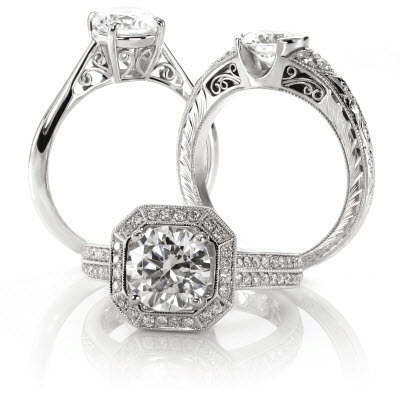
Knox Jewelers will now be carrying Lab Created Diamonds as center stone options to feature in our custom engagement rings. But before you decide if this natural diamond alternative is right for you, you may like a a brief explanation on how these man-made diamonds are created.
Created diamonds are grown in a laboratory and will have the same basic crystal structure and chemical composition as natural diamonds that were formed over millions of years, deep underground. In-depth research and development of a man-made diamond has been in progress for the past thirty years, but only recently has there been the successful creation of quality crystals, large enough for use in jewelry.
A laboratory created diamond is a gemstone produced by artificial means in a control process rather than natural diamonds, which are created by geological processes deep inside the earth. Lab created diamonds are often designated as either a High Pressure High Temperature (HPHT) diamond or Chemical Vapor Deposition (CVD) diamond, depending on which process was utilized in their formation. HPHT and CVD are the two most common production methods currently in practice for created diamonds. These laboratory gemstones are made from pure crystallized carbon, the same structural material as earth mined diamonds.
Ever since the early nineteenth century there has been interested and experimentation in producing a diamond, but the exact process of duplicating the extreme pressure and temperature which natural diamonds are formed under remained a mystery. General Electric, in 1955, took the first steps in technological development and created the first laboratory diamonds, though they were small and only usable in industrial settings. Ever since then, the distinct processes that create a lab diamond have only become more refined. The end result, a fully developed laboratory diamond, is now available to feature as the center stone in a one-of-kind Knox engagement ring.
High Pressure High Temperature (HPHT) Lab Created Diamond
The HPHT process is used to recreate the conditions of a natural diamond’s birth, where they form close to 150-200 km below the Earth’s surface. This growth process is slow and well-controlled. This steady growth is essential for creating high quality laboratory diamonds. The creation of a gem-quality stone close to one carat will takes about three days to crystallize.
Most HPHT diamonds are created the same way, though there are three main press designs used to supply the pressure and temperature necessary to produce a crystal. Currently the belt press, the cubic press and the split-sphere (BARS) press are all actively producing gem-quality stones.
A diamond seed is placed at the bottom of a press. This seed may be of natural or synthetic origin, and will be close to the thickness of a fingernail. The internal part of press is heated by a tubular, graphite heater. This generates temperatures above 1400°C, replicating deep underground, and melts the solvent material that has been placed in the press. The molten material dissolves and mixes with a high level carbon source, which is then transported to the diamond seeds and grows, forming a large synthetic diamond.
Chemical Vapor Deposition (CVD) Lab Created Diamond
Chemical vapor deposition is a growth method where a diamond can be created from only a hydrocarbon gas mixture. Unlike HPHT gemstones, CVD diamonds do not require high pressures to form. This process is comparatively more simple than HPHT, with less necessary equipment and materials.
The CVD process involves feeding varying amounts of gases into a chamber and energizing them. The gases always include a carbon source, typically methane, and hydrogen. Hydrogen is essential because it selectively etches off non-diamond carbon. The gases are ionized with heat into chemically active radicals that collect to form diamond crystals.
Both of these processes form beautiful man-made diamonds that are faceting and waiting to be selected.
If a lab created diamond option is in your interest, please contact us today to inquire on the available selection of gemstones. We can search our current collection for the perfect grown diamond option to become the finishing touch to your beautiful handcrafted piece.



